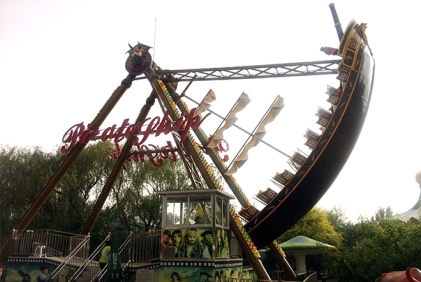Introduction to the Rotating Aircraft Principles of Rotating Flying Chair What are the safety hazards of Rotating Flying Chairs...
2025-02-04 13:02:05 Views:0
RotateFlying chairIt is one of the most visually tensioned facilities in the playground. When dozens of suspended seats draw beautiful parabolic trajectories in the air, it is like a magical aerial ballet. This seemingly simple amusement equipment is actually the perfect crystallization of Newtonian mechanics and mechanical engineering. Visitors looking up from the ground often marvel at their elegant movement trajectory, but do not know that behind this is the exquisite dynamic principle and rigorousSafetydesign.
1. Precision coordination of power systems
The central drive tower of the rotating flying chair is the core of the entire system. It is equipped with a high-power frequency converter motor, which can complete the start response within 0.5 seconds. Through the planetary gear reduction mechanism, the motor speed is reduced to the safe range, while the output torque is increased to 300 times the initial value. The rotating platform on the top of the tower is cast using aviation-grade aluminum alloy, which ensures structural strength while reducing weight. The surface is anodized to resist wind and rain erosion.
The suspension system adopts a double-layer safety design, each sling is woven from 128 strands of stainless steel wire, and a single load-bearing capacity of 1.5 tons. The seat suspension point is equipped with universal bearings, allowing the seat to swing out naturally under the action of centrifugal force. The latest flying chair is also equipped with a dynamic balance monitoring system to detect the stress status of each seat in real time to ensure balanced load distribution.
The control system integrates a PLC programmable logic controller and an IoT module, and the operator can accurately set speed, acceleration and other parameters through the touch screen. The safety circuit system includes three sets of independently operating brake devices, which can complete emergency braking in 0.3 seconds, and its response speed is 5 times faster than the thrust-reverse device of civil aviation passenger aircraft.
2. Mechanical code of centrifugal motion
When the flying chair is started, the centrifugal force generated by rotation causes the seat to gradually swing outward, and this process follows Newton's law of motion. The centrifugal force calculation formula F=mω²r shows that as the rotation speed (ω) increases and the rotation radius (r) increases, the "weight loss" felt by passengers increases geometrically. The modern flying chair controls the maximum centripetal acceleration within 3g, which not only ensures a stimulating experience but also meets the human body's tolerance limit.
The corresponding relationship between the seat swing angle and rotation speed forms a dynamic balance. When the rotation speed reaches the design value, the seat will naturally stabilize at an angle of 55-60 degrees. At this time, the combined force direction of the sling tension and centrifugal force is exactly pointing to the center of rotation. This exquisite mechanical balance allows passengers to feel both strong external force without real sense of loss of control.
In terms of safety protection, the five-point seat belt is made of racing-grade materials and has a tensile strength of more than 20kN. The electromagnetic locking device is linked to the speed sensor and cannot be unlocked until the device is completely stopped. The seat guard rod is embedded with a buffer spring, which can absorb the impact energy generated by sudden change of speed and control the G-value fluctuation within a safe range.


















